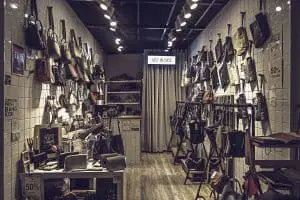Introduction
The “Made In … ” label is something that we now much less likely to notice on everyday products, as fewer and fewer companies are able to maintain a cost-efficient domestic manufacturing production. Moreover, countries which in the past might have had a low reputation for quality in manufacturing are now stepping up their game and achieving standards of production which are easily comparable to the more developed economies.
The “country of origin effect” contributes significantly to the perceived value of a product, and fashion firms need to manage this element in a strategic way. The country of origin effect relates to the values that consumers traditionally associate to a country’s reputation for excellence, and delivers value both to a domestic and international audience.
Here are the main topics we are going to cover in this post.
1. The Country of Origin Effect
2. A brief history of the fashion industry in Italy
3. The “Made in Italy”“
4. The business reality in Italy
5. Conclusions
1. The Country of Origin Effect
As companies expand internationally, they get an opportunity to re-organise their value chain (as discussed in this post: A Brief Introduction to the Fashion Industry).
Moving a company’s manufacturing processes abroad can serve a variety of purposes: cost reduction, transport efficiencies or even avoidance of tariff barriers.
In international marketing, outsourcing production is a very effective strategy to reduce costs and achieve a more competitive price point. On the other hand, the degree of quality control and production standards of a product can be heavily impacted by this decision, as companies trade may end up trading quantity for quality.
In the world of fashion and luxury, some firms have decided to resist the temptation to exploit this cost-reduction opportunity and decided to maintain domestic production, knowing that if certain standards of manufacturing excellence are maintained, the quality of their products will gain a competitive edge against competitors.
The country of origin effect plays two vital roles in influencing consumer behaviour in both domestic and international markets:
- The Country of Origin effect reinforces the value of a brand in relation to foreign markets. This is achieved by stressing the legacy of excellence and craftsmanship associated with a geographical location. The “Made in Italy” and “Made in France” labels allow Italian and French products to provide a sense of quality and craftsmanship which few other countries can claim.
- The Country of Origin appeals to a national sense of pride when selling products to the domestic market. As an example, the “Made in the USA” label, allows a firm to leverage a sense of patriotic sentiment. In this case, the COO does not focus on the location of manufacturing, as much as on a brand’s alignment with the values of the American Dream.
The concept of “Made In” in fact is can be used elastically – to say the least-, to include a geographical denomination related to any of the segments of the value chain. This is the case for Apple, which for instance uses the expression “Designed in California, assembled in China” to reinforce the fact that the design stage (or the research and development stage within the value chain model) takes place in California, whereas the actual manufacturing – or mere assembly – takes place in China.
Each “Made In” label can covey different sets of values which connect to the intangible heritage of a country. In France, the COO associates products to forms of art. Made in Italy is a blend of design and comfort. Let’s look into Made in Italy a little bit further to see where this legacy of quality comes from.
2. A brief history of the fashion industry in Italy
Italy as a country has played a fundamental role in the evolution of fashion manufacturing, and the Made in Italy label has become a global synonym of quality manufacturing. Studying the development of the Italian fashion industry can assist us in understanding how this COO effect was created and maintained with the “Made in Italy” label.
To capture the trajectory of Italy’s fashion manufacturing evolution, we need to focus on three typologies of business players who were able to influence the growth of the Italian fashion industry over the last 50 years: designers, entrepreneurs, and the textile industries.
Moreover, the Italian fashion system underwent three distinct cycles, lasting an average of 15 years each:
- Stage 1: the development of industrial production from the 1950s to the 1960s. During this stage, Italian companies were mainly fashion apparel manufacturers, who physically created collections on behalf of French designers. This is the era of the “total looks” which made French Maisons famous worldwide.
In 1951, in the Sala Bianca of Palazzo Pitti in Florence, the first Italian fashion show took place. This show delivered the first statement on the state of fashion in Italy or the ‘Italian Fashion Look’. This new product line is what we now call Ready-To-Weary or Pret-a-porter, and in evident competition with the French couturiers, Italian designers created fashion garments for a new, broader category of users. In this occasion the first statement about Italian fashion was made: Italian designers pursued quality, but they also targeted a wider audience of customers who wanted to be dressed sharply and comfortably.
- Stage 2: from the mid-1960s to the mid-1970s. In these decades, the demand for haute couture clothing decreased, as a new mid-tier market was starting to take form. Not all manufacturing companies were able to adapt to the requirements of a more flexible and faster market. This prompted new models of manufacturing, whereby the relationship between manufacturing firms and fashion designers grew closer and closer in order to cater to a new generation of users. At the same time, new visionary designers established their first Italian Maisons, increasing and reinforcing the value of Italian fashion appeal towards both domestic and international customers. As the fashion cycles needed to be faster and produce higher volumes of products, the Italian manufacturers caught the opportunity to scale and reach scale economies and become a leading national industry.
- Stage 3: the 1980s and the growth of the Made in Italy. In this stage, the synergy between Italian designers and manufacturing companies became less of a business relationship and more of a partnership. Designers like Giorgio Armani created the first licensing agreements, connecting the two ends of the fashion industry: design and manufacturing. This alliance created high-quality products that boosted the Italian COO, making it an international symbol of quality.
Italian manufacturers were able to achieve premium price points by connecting the high-quality output of their production pipeline with the new, more inclusive vision of Italian fashion.
By making a comparison with those countries (such as India and China) which are now serving as manufacturing hubs for western brands, there is no reason to doubt that in time, these countries too will develop their own prestigious designers and influence fashion on a global scale.
3. The “Made In Italy”
As we have discussed, by looking at the evolution of the fashion manufacturing industry in Italy we can quickly identify all of the elements that made this country internationally famous.
The Made in Italy, is not a label that can be applied lightly or indiscriminately to every product manufactured in Italy. The Made in Italy is an abstract concept, leveraging on the history of fashion in Italy. Made in Italy is a signature that testifies a firm’s unique competitive advantages in terms of innovation, style, service, and price.
A Made In Italy label is a statement and a manifest, identifying a product with unique characteristics.
- A blend of creativity and functionality will inspire a product’s design.
- A small volume of craftsmanship manufacturing will testify a product’s quality.
- A product’s manufacturing will rely on fashion districts and small family-run businesses that allow for flexibility, specialisation and continuity.
- A product will be subject to extensive quality control over the entire production process: from the yarn selection to the garment distribution.
- A product will embody “The Renaissance Effect”, a consequence of living in the world’s biggest open-air museum, influenced by the Italian aesthetic sensibility.
These values turn into perceptions for foreign consumers who associate lifestyle values to the Italian brands, such as la dolce vita.
4. The contemporary business reality in Italy
The reality of contemporary the fashion industry in Italy is not only comprised of small family businesses, it features 4 distinct categories of players:
- Industrial companies. Industrial companies acquire brands (mostly, previous licensors) launch their own brands and develop retail strategies to connect with customers (MoschinoFerrèMax MaraZegna).
- Designers and Entrepreneurs. These players control production and distribution processes; very few licenses are issued to outsourced manufacturers (Armani, Dolce and Gabbana, Versace).
- Multi-brand Groups. These groups are fashion conglomerates that acquire brands and designer companies, especially in the luxury segment (Gucci Group, Prada Group).
- Pure Designers. As they grow, they usually end up being acquired by industrial multi-brand groups (Valentino).
Over the last 20 years, the Italian fashion firms have grown tremendously and are now looking towards “the East” to outsource its second lines and bridge lines. In this context, it is likely that just like the Made in the USA, the Made in Italy will gain a more intangible value, connected to the inspiration of the product’s design more than its location of production.
5. Conclusions
The COO effect is a marketing tool used by companies to transfer the traditional values of a country their brand.
A company wishing to leverage this element in their marketing strategy should try and strike a balance: on the one hand, is should reinforce the value associations which are rooted in a country’s heritage, on the other hand, it needs to work on revitalising the country’s culture, bringing traditional and historical values back into the present.
In this sense, the COO is not a static element, but a dynamic one. Fashion firms should take on the responsibility of renovating the value of their culture and heritage, making it ‘resonate‘ with new categories of customers.
If you’re interested to learn more about the way in which brands use their country of origin to develop a luxury positioning strategy for their brand, look below, we have many more resources for you to explore. Enjoy!
If you’re interested in learning more about the Fashion Industry, don’t hesitate to take a look at our course “The Fashion Industry: Explained”. Our in-depth class covers a wide range of topics spanning from understanding fashion customers and markets to developing immersive retail experiences for your customers. Here’s a link to the course, if you use the discount code BLOG20 you can access a 20% discount. Enjoy!







